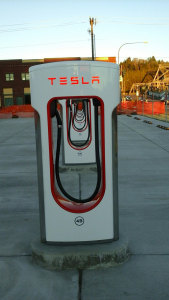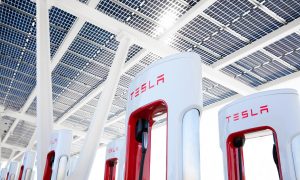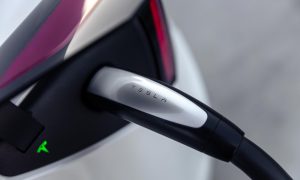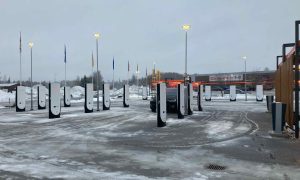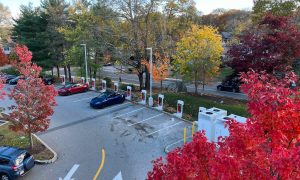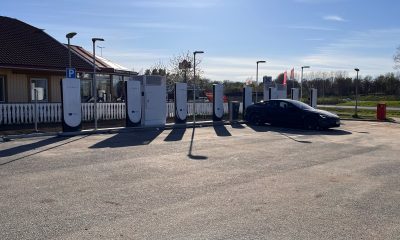News
Mayor tied to Tesla Supercharger site questioned over ‘conflict of interest’
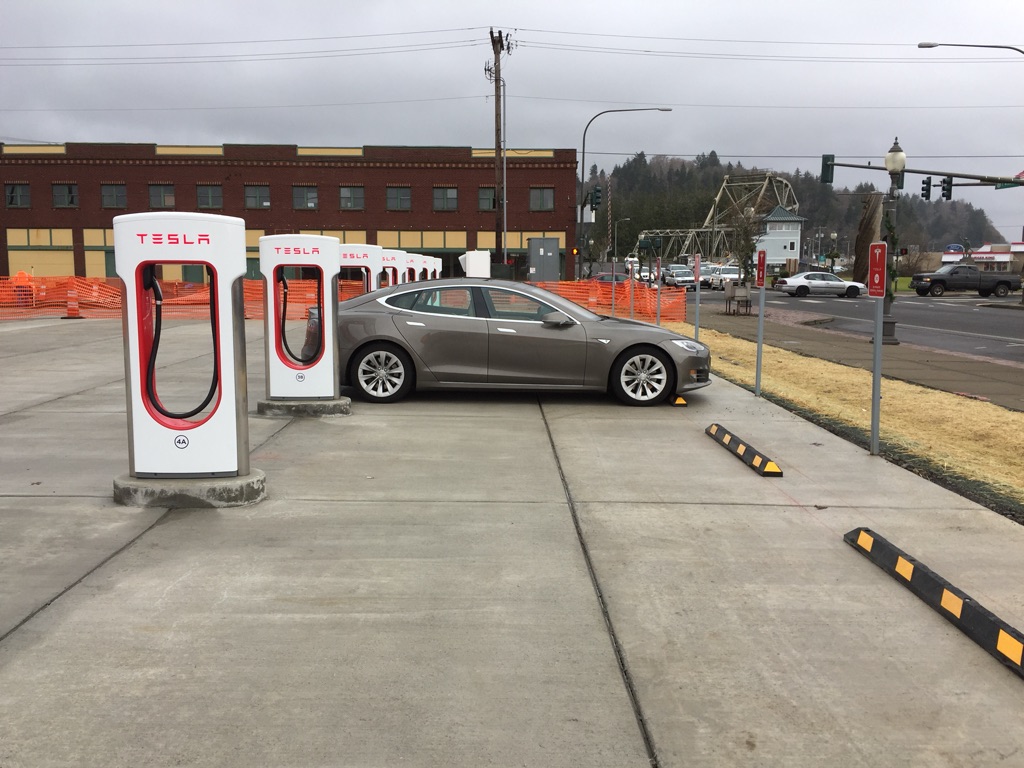
He was young. Ambitious. Gifted. One of the greatest players to ever set foot on a professional baseball diamond, “Shoeless” Joe Jackson’s career ended in tatters for his alleged role in the infamous Chicago “Black Sox scandal” of 1919.
Call it a “conflict of interest.” It involved money. Lots of it.
Something else that involves money – lots of it – is afoot in Aberdeen, Washington: A Tesla Supercharger station and a “Gateway Center.” Aberdeen Mayor Erik Larson is a staunch proponent of both.
Updated: Mayor Larson fines himself $500 for violating the state’s conflict of interest ethics code
Mayor Larson is making the rounds looking for funding to help cover the costs of Gateway Center construction which is expected to cost upwards of $8M to complete, and incorporate Tesla’s Supercharger station into the design.
Questions within the community are swirling around what appears to be a conflict of interest regarding the mayor’s involvement in the Tesla deal. Documents have surfaced showing that the mayor has, or had, a financial interest in the electric car company that’s building the Supercharger station, apparently while he was negotiating with the company to bring the project to a city-owned lot. Why the station is being built on publicly owned land rather than on a private site is also in question.
Background
Mayor Larson negotiated the original agreement with Tesla for the charging station, which could have cost the city up to $2,000 a month in utility bills. The lease agreement came before the Aberdeen City Council for approval last summer. Originally, the City of Aberdeen was on the hook for paying electricity costs.
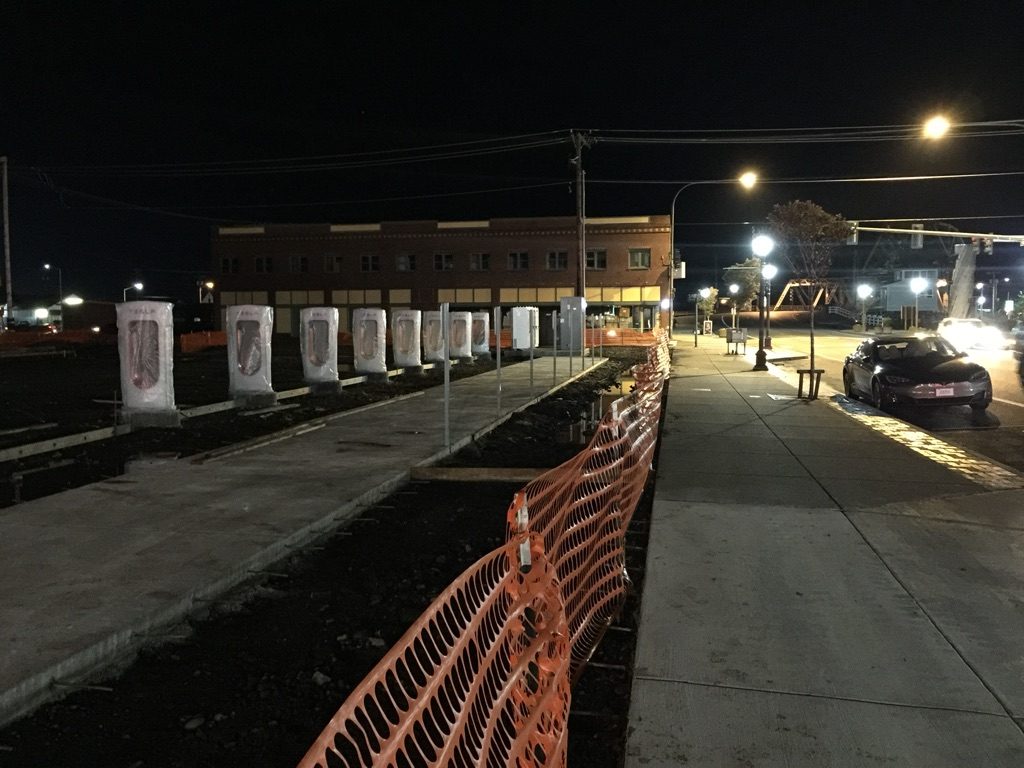
Tesla Supercharger station in Aberdeen, Washington during construction [Credit: Trebor Thickweb via app check-in]
As noted in the Aberdeen City Council meeting agenda dated July 13, 2016, the lease language at that time included (see page three):
“The Mayor has negotiated with Tesla Motors, Inc. for the construction of a Tesla supercharger station in Aberdeen on the city of the former Chevron station. The supercharger will be incorporated into the design of the Gateway Center. … the city will also be responsible for… paying the utility bills for Tesla vehicles that use the charging station, up to monthly cap of $2,000 per month.” (Emphasis added.)
Reading further, Item 8 of that actual lease agreement specifies that:
“Tesla agrees to arrange for all Tesla-related utility services provided or used in or at the Premises… Tesla shall pay directly to the utility company the cost of installation of any all such Tesla-related utility services and shall arrange to have the utility service separately metered. (Counterparty) shall be responsible for paying all utility bills related to such meter after installation, including payment for electricity consumed at the Premises during the Term, up to two thousand dollars ($2,000) per month.” (Emphasis added.)
Other Cities, Other Charging Stations
Tesla lease agreements with city governments aren’t new. Similar charging stations exist in five other Washington cities: Centralia, Burlington, Ellensburg, Kennewick, and Ritzville. There are eleven Supercharger stations in Oregon. All are located on either hotel/resort type private property or some other type of retail/outlet center. But the Aberdeen location is on a city-owned lot.
In California, two Supercharging stations on publicly owned property exist in Ukiah and Crescent City. But the terms negotiated by those cities for the stations are jarringly different from those negotiated for the Aberdeen site:
In Ukiah:
– “Tesla pays for the entire project, including staff time and utility costs.” (Ukiah Daily Journal, August 8, 2015.)
In Crescent City:
- The city is being paid by the tenant for use of its property. A proposal by Recargo, Inc. to build and operate a universal electric vehicle charging station in Crescent City included a $4,800 annual payment from Recargo to the district for use of the property. (Del Norte Triplicate, October 11, 2016.)
- “Essential components” of the city’s lease agreement with Tesla includes: “(1) the term, which is five years with two five-year options to renew, (2) Tesla will build and maintain the facility, and (3) the lease amount is one dollar per month.” (City of Crescent City Council Agenda Report, April 6, 2015.)
- Tenant “agrees to arrange for and pay for all Tenant-related utility services provided or used in or at the Premises during the term of the Lease.” (#10 – Utilities – City of Crescent City Ground Lease for Tesla Supercharging Station, April 6, 2015.)
- “Tenant shall pay directly to the utility company the cost of installation of any and all such Tenant-related utility services and shall arrange to have the utility service separately metered.” (#10, Utilities – City of Crescent City Ground Lease for Tesla Supercharging Station, April 6, 2015.)
In Aberdeen:
- The city (re: taxpayers) could get stuck with “up to 30,000 for the costs of installing the new infrastructure for the city” per the re-negotiated August agreement.
- The provision requiring the city to pay for electricity used by Tesla vehicles was removed.
- The proposed new lease requires Tesla to pay for all costs of charging Tesla vehicles.
- The lease also requires Tesla to install infrastructure “that would allow the city to add charging stations for other electric vehicles at some point in the future.”
- The city “will reimburse Tesla up to $30,000 for the costs of installing the new infrastructure for the city.” (Emphasis added.)
According to minutes from the August 24, 2016 Aberdeen City Council Meeting, a motion to adopt the re-negotiated lease agreement carried.
An interesting wrinkle, as announced by Tesla on November 7, 2016, is that Tesla has decided to stop offering unlimited free use of its network fast-charging stations worldwide beginning this year.
So, other than hopes of helping “attract potential tenants to the center as the first project participant” and providing “nearby restaurants and retailers with additional business” per Mayor Larson, just how, exactly, does the supercharging station tangibly benefit Aberdeen taxpayers or offset “up to $30,000” in reimbursements to Tesla “for the costs of installing the new infrastructure for the city”?
The Daily World reports that “A $30,000 grant will help Aberdeen reimburse Tesla for installing the station.” In light of the agreements hammered out with other cities for charging stations on public land, however, why is Aberdeen on the hook for reimbursing Tesla for any installation costs?
Another wrinkle:
According to an October 28, 2016 story in The Daily World, five Aberdeen sites were in the running as possible locations for the new Supercharger station, including the parking area for the Center. Larson explains:
“They (Tesla) could have easily worked with Gateway Mall or sought out private ownership, but they were interested in the Gateway Center parking lot.”
Why was a publicly owned site selected instead of a privately owned one? Is city government using public funds to compete with private business?
Additional questions swirl around Mayor Larson’s financial interest in Tesla Motors.
Some questions:
- Did Mayor Larson disclose his financial interest/common stock in Tesla Motor Company anywhere other than on his 2015 and 2016 PDC F-1 forms?
- As a candidate, Mayor Larson reported his stock value as $4.5K – $23.9K. After he was elected, he reported the value as $24K – 47.9K. What’s up with that?
- The mayor apparently handled all negotiations with Tesla, even though he had/has a financial interest in the motor company (See PDC F-1 forms, above). Did the city know about his financial interest in this company? If so, did it okay the mayor as negotiator of the Tesla lease agreement anyway? Why?
Perhaps a contract negotiator sans an apparent financial interest in the project under negotiation might be a good idea?
While we’re raising questions, what of Shoeless Joe? After the Black Sox scandal, Jackson never set foot on a professional baseball diamond again. He was banned for life along with seven other Chicago players for their alleged involvement in intentionally throwing the 1919 World Series to the Cincinnati Reds. Jackson’s alleged involvement in the conspiracy is still the subject of hot debate. Some maintain that the only things Joe was guilty of were being young, ambitious, gifted, and a bit naive.
Ring any bells?
Kristine Lowder
This guest post was written by Kristine Lowder of Conservelocity. Do you have a post you’d like to share? Email it to us at info@teslarati.com
News
Tesla UK sales see 14% year-over-year rebound in June: SMMT data
The SMMT stated that Tesla sales grew 14% year-over-year to 7,719 units in June 2025.

Tesla’s sales in the United Kingdom rose in June, climbing 14% year-over-year to 7,719 units, as per data from the Society of Motor Manufacturers and Traders (SMMT). The spike in the company’s sales coincided with the first deliveries of the updated Model Y last month.
Model Y deliveries support Tesla’s UK recovery
Tesla’s June performance marked one of its strongest months in the UK so far this year, with new Model Y deliveries contributing significantly to the company’s momentum.
While the SMMT listed Tesla with 7,719 deliveries in June, independent data from New AutoMotive suggested that the electric vehicle maker registered 7,891 units during the month instead. However, year-to-date figures for Tesla remain 2% down compared to 2024, as per a report from Reuters.
While Tesla made a strong showing in June, rivals are also growing. Chinese automaker BYD saw UK sales rise nearly fourfold to 2,498 units, while Ford posted the highest EV growth among major automakers, with a more than fourfold increase in the first half of 2025.
Overall, the UK’s battery electric vehicle (BEV) demand surged 39% to to 47,354 units last month, helping push total new car sales in the UK to 191,316 units, up 6.7% from the same period in 2024.
EV adoption accelerates, but concerns linger
June marked the best month for UK car sales since 2019, though the SMMT cautioned that growth in the electric vehicle sector remains heavily dependent on discounting and support programs. Still, one in four new vehicle buyers in June chose a battery electric vehicle.
SMMT Chief Executive Mike Hawes noted that despite strong BEV demand, sales levels are still below regulatory targets. “Further growth in sales, and the sector will rely on increased and improved charging facilities to boost mainstream electric vehicle adoption,” Hawes stated.
Also taking effect this week was a new US-UK trade deal, which lowers tariffs on UK car exports to the United States from 27.5% to 10%. The agreement could benefit UK-based EV producers aiming to expand across the country.
News
Tesla Model 3 ranks as the safest new car in Europe for 2025, per Euro NCAP tests
Despite being on the market longer than many of its rivals, the Tesla Model 3 continues to set the bar for vehicle safety.

The Tesla Model 3 has been named the safest new car on sale in 2025, according to the latest results from the Euro NCAP. Among 20 newly tested vehicles, the Model 3 emerged at the top of the list, scoring an impressive 359 out of 400 possible points across all major safety categories.
Tesla Model 3’s safety systems
Despite being on the market longer than many of its rivals, the Tesla Model 3 continues to set the bar for vehicle safety. Under Euro NCAP’s stricter 2025 testing protocols, the electric sedan earned 90% for adult occupant protection, 93% for child occupant protection, 89% for pedestrian protection, and 87% for its Safety Assist systems.
The updated Model 3 received particular praise for its advanced driver assistance features, including Tesla’s autonomous emergency braking (AEB) system, which performed well across various test scenarios. Its Intelligent Speed Assistance and child presence detection system were cited as noteworthy features as well, as per a WhatCar report.
Other notable safety features include the Model 3’s pedestrian-friendly pop-up hood and robust crash protection for both front and side collisions. Euro NCAP also highlighted the Model 3’s ability to detect vulnerable road users during complex maneuvers, such as turning across oncoming traffic.
Euro NCAP’s Autopilot caution
While the Model 3’s safety scores were impressive across the board, Euro NCAP did raise concerns about driver expectations of Tesla’s Autopilot system. The organization warned that some owners may overestimate the system’s capabilities, potentially leading to misuse or inattention behind the wheel. Even so, the Model 3 remained the highest-scoring vehicle tested under Euro NCAP’s updated criteria this year.
The Euro NCAP’s concerns are also quite interesting because Tesla’s Full Self-Driving (FSD) Supervised, which is arguably the company’s most robust safety suite, is not allowed for public rollout in Europe yet. FSD Supervised would allow the Model 3 to navigate inner city streets with only minimal human supervision.
Other top scorers included the Volkswagen ID.7, Polestar 3, and Geely EX5, but none matched the Model 3’s total score or consistency across categories. A total of 14 out of 20 newly tested cars earned five stars, while several models, including the Kia EV3, MG ZS, and Renault 5, fell short of the top rating.
Elon Musk
Why Tesla’s Q3 could be one of its biggest quarters in history
Tesla could stand to benefit from the removal of the $7,500 EV tax credit at the end of Q3.

Tesla has gotten off to a slow start in 2025, as the first half of the year has not been one to remember from a delivery perspective.
However, Q3 could end up being one of the best the company has had in history, with the United States potentially being a major contributor to what might reverse a slow start to the year.
Earlier today, the United States’ House of Representatives officially passed President Trump’s “Big Beautiful Bill,” after it made its way through the Senate earlier this week. The bill will head to President Trump, as he looks to sign it before his July 4 deadline.
The Bill will effectively bring closure to the $7,500 EV tax credit, which will end on September 30, 2025. This means, over the next three months in the United States, those who are looking to buy an EV will have their last chance to take advantage of the credit. EVs will then be, for most people, $7,500 more expensive, in essence.
The tax credit is available to any single filer who makes under $150,000 per year, $225,000 a year to a head of household, and $300,000 to couples filing jointly.
Ending the tax credit was expected with the Trump administration, as his policies have leaned significantly toward reliance on fossil fuels, ending what he calls an “EV mandate.” He has used this phrase several times in disagreements with Tesla CEO Elon Musk.
Nevertheless, those who have been on the fence about buying a Tesla, or any EV, for that matter, will have some decisions to make in the next three months. While all companies will stand to benefit from this time crunch, Tesla could be the true winner because of its sheer volume.
If things are done correctly, meaning if Tesla can also offer incentives like 0% APR, special pricing on leasing or financing, or other advantages (like free Red, White, and Blue for a short period of time in celebration of Independence Day), it could see some real volume in sales this quarter.
You can now buy a Tesla in Red, White, and Blue for free until July 14 https://t.co/iAwhaRFOH0
— TESLARATI (@Teslarati) July 3, 2025
Tesla is just a shade under 721,000 deliveries for the year, so it’s on pace for roughly 1.4 million for 2025. This would be a decrease from the 1.8 million cars it delivered in each of the last two years. Traditionally, the second half of the year has produced Tesla’s strongest quarters. Its top three quarters in terms of deliveries are Q4 2024 with 495,570 vehicles, Q4 2023 with 484,507 vehicles, and Q3 2024 with 462,890 vehicles.
-

 Elon Musk4 days ago
Elon Musk4 days agoTesla investors will be shocked by Jim Cramer’s latest assessment
-

 News1 week ago
News1 week agoTesla Robotaxi’s biggest challenge seems to be this one thing
-

 Elon Musk2 weeks ago
Elon Musk2 weeks agoFirst Look at Tesla’s Robotaxi App: features, design, and more
-

 News2 weeks ago
News2 weeks agoSpaceX and Elon Musk share insights on Starship Ship 36’s RUD
-

 News2 weeks ago
News2 weeks agoWatch Tesla’s first driverless public Robotaxi rides in Texas
-

 News1 week ago
News1 week agoWatch the first true Tesla Robotaxi intervention by safety monitor
-

 News2 weeks ago
News2 weeks agoTesla has started rolling out initial round of Robotaxi invites
-

 Elon Musk2 weeks ago
Elon Musk2 weeks agoTesla to launch in India in July with vehicles already arriving: report

